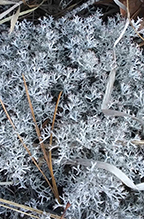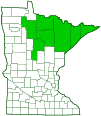Black-footed Reindeer Lichen
(Cladonia stygia)
Conservation • Description • Ecology • Distribution • Taxonomy
|
|
||||||||||||||
Description |
Black-footed Reindeer Lichen is a slow growing, long-lived, shrubby lichen. It occurs in Europe, Asia, and North America. It occurs throughout Canada and Alaska. In the contiguous United States, it occurs from Maine to New York, west to northern Minnesota, and south along the Appalachian Mountains to North Carolina. It is primarily a boreal species, but its range extends into the arctic zone and the temperate zone. It is especially common in the transition zone from boreal forest to treeless tundra. It is found in a variety of habitats, especially in bogs and other open wetlands, but also in upland sites, including in boulder fields, on mountain slopes, and on the ground in forests. It grows on soil, on plant debris, and on mosses. Black-footed Reindeer Lichen is common over large areas. It is very similar to Gray Reindeer Lichen, it often grows mixed in with Gray Reindeer Lichen, and it is often labeled as Gray Reindeer Lichen in herbaria. However, it tolerates a more restricted range of ecological conditions than Gray Reindeer Lichen. Chemical analysis suggests, and molecular analysis confirms, that the two species are distinct. The vegetative body (thallus) is a shrubby tuft of many branching stems. The primary thallus is inconspicuous and composed of scaly, flaky, rounded, prostrate pieces (squamulose). It is ephemeral and it is usually not visible. The secondary thallus is conspicuous, upright, three dimensional, and shrubby (fruticose). It is composed of numerous, richly branched, hollow stalks (podetia). The podetia are usually about 2″ to 5⅞″ (5 to 15 cm) tall. In very wet areas, they grow at a rapid rate, up to ¾″ (2 cm) per year and can reach a height of 11¾″ (30 cm). The living upper portion is up to 4″ (10 cm) tall. The surface color is ash gray to bluish gray or olive gray (the latter especially in wet areas or when wet), or yellowish white (cream-colored, ivory, or off white). The podetia grow upward at the tip and die back at the base. They readily absorb moisture, becoming flexible when moist, crusty when dry. The inner tissue turns coal black and can be seen beneath the light-colored surface layer high up on the podetia. The main branches are 1⁄32″ to 1⁄16″ (0.8 to 2.0 mm) wide. The surface of young upper branches is felty. The surface of older, lower branches is covered with small, wart-like elevations (verruculose). Each branch ends in two to four short branchlets. The branchlets may spread in all directions, or they may point in the same direction but much less strongly so than on Gray Reindeer Lichen. The branchlet tips are strongly browned. Spores are produced at the tip of each branchlet. Separate, cup-shaped, spore-producing structures (apothecia) are rarely produced. |
Similar Species |
Gray Reindeer Lichen (Cladonia rangiferina) tends to be lighter in appearance, and it never shows any hint of green pigmentation. The branchlets are strongly pointed in the same direction. |
Ecology |
Substrate |
Soil, plant debris, and moss |
Growth Form |
Fruticose |
Habitat |
Bogs and other open wetlands, boulder fields, mountain slopes, and forests |
Hosts |
|
Distribution |
||
|
Sources AHTI, T., & HYVÖNEN, S. (1985). Cladina stygia, a common, overlooked species of reindeer lichen. Annales Botanici Fennici, 22(3), 223–229. http://www.jstor.org/stable/23725708 |
|
| 3/2/2024 | ||
Occurrence |
||
|
||
Taxonomy |
|
Kingdom |
Fungi (fungi including lichens) |
Subkingdom |
Dikarya |
Phylum |
Ascomycota (Sac Fungi) |
Subphylum |
Pezizomycotina (Sac Fungi and Lichens) |
Class |
Lecanoromycetes (Common Lichens) |
Subclass |
Lecanoromycetidae (Shield Lichens, Sunburst Lichens, Rosette Lichens, and Allies) |
Order |
Lecanorales (Shield Lichens, Rim Lichens, and Allies) |
Family |
Cladoniaceae (Spindles and Structured Lichens) |
Genus |
Cladonia (Pixie Cup and Reindeer Lichens) |
Mycobiont |
Cladonia stygia |
Photobiont |
Green algae other than Trentepohlia |
This lichen was originally described in 1826 as Cladonia rangiferina f. stygia, a color form of the more widespread Gray Reindeer Lichen. In 1828, it was re-described as the full species Cladonia stygia. In the early 20th century, some taxonomists moved this and some other Cladonia species to the new genus Cladina based on morphological and chemical differences. More recent chemical and molecular analyses suggested that those differences do not warrant separate genus status. By 2008, many taxonomists had re-integrated Cladina back into Cladonia as a subgenus. Currently, the majority of taxonomists and databases recognize Cladonia stygia as the accepted name. |
|
Subordinate Taxa |
|
|
|
Synonyms |
|
Cenomyce gonorega f. scabrosa Cenomyce rangiferina var. curta Cenomyce squamosa var. scabrosa Cladina stygia Cladonia degenerans f. scabrosa Cladonia rangiferina f. curta Cladonia rangiferina f. stygia Cladonia squamosa var. scabrosa |
|
Common Names |
|
Black-footed Reindeer Black-footed Reindeer Lichen Styx Black-Footed Reindeer Lichen |
|
Glossary
Apothecium
An open, disk-shaped or cup-shaped, reproductive structure, with spore sacs on the upper surface, that produces spores for the fungal partner of a lichen. Plural: apothecia.
Fruticose
Shrubby: referring to the growh form of lichens that may be tufted, draped, or stalked.
Podetium
The hollow stalk of the fruiting body of lichens in the genus Cladonia. Plural: podetia.
Thallus
In lichens: The vegetative body of a lichen composed of both the alga and the fungus. In liverworts: a flat, relatively undifferentiated plant body. Plural: thalli.
Visitor Photos |
||
Share your photo of this lichen. |
||
This button not working for you? |
||
Luciearl |
||
|
||
MinnesotaSeasons.com Photos |
||
|
|
|
|
|
|

Slideshows |
|

Visitor Videos |
||
Share your video of this lichen. |
||
This button not working for you? |
||
|
Other Videos |
||
|

Created: 3/2/2024 Last Updated: © MinnesotaSeasons.com. All rights reserved. |



